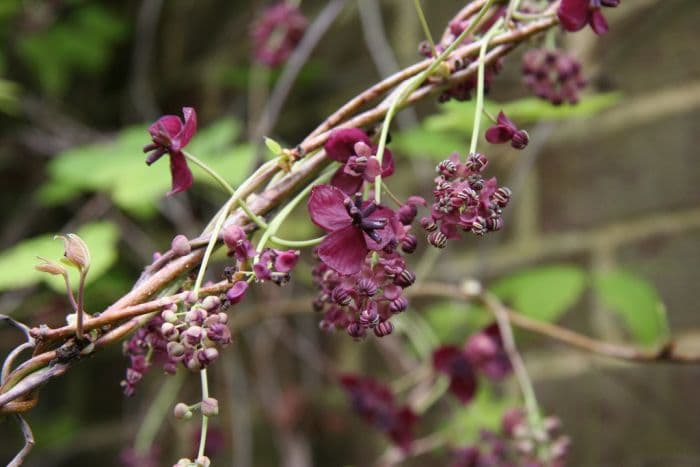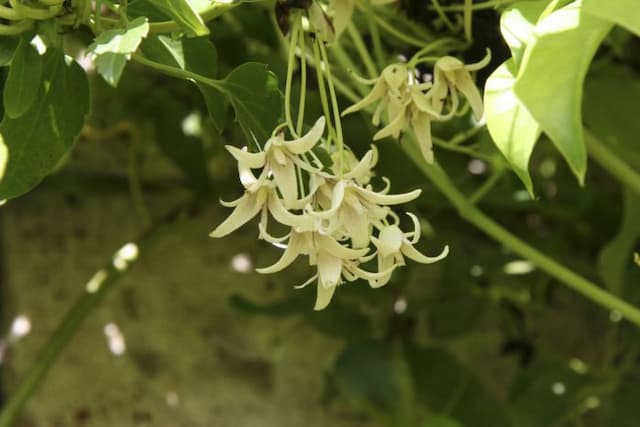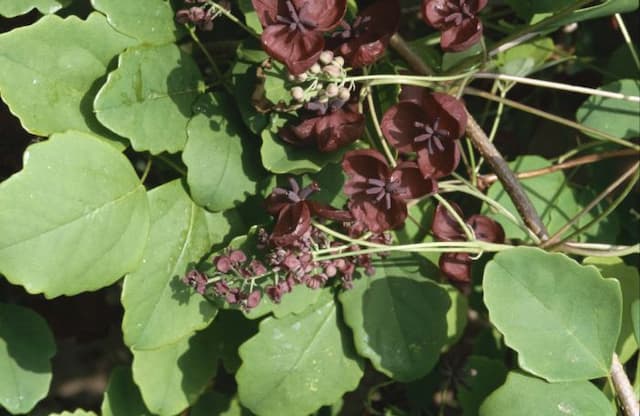Chocolate Vine Akebia × pentaphylla

ABOUT
The plant known as the Chocolate Vine is a deciduous to semi-evergreen climber, boasting a twining growth habit that allows it to ascend structures and other plants with relative ease. Its leaves are palmately compound, typically composed of five oval to oblong leaflets that create a hand-like shape, showcasing an attractive color composition ranging from green to blue-green hues. During the blooming season, the Chocolate Vine is graced with enchanting clusters of small, bell-shaped flowers. These blossoms exhibit a soft, purplish to reddish-brown tint, often described as chocolate-colored which contributes to its common name. Their sweet fragrance is another alluring characteristic, adding a sensory appeal to its aesthetic beauty. Adding to its ornamental value, post-flowering, the plant produces elongated, sausage-shaped fruits. These fruits start with a shade of green and gradually mature to a more purplish tint, housing edible pulp inside. The Chocolate Vine's intertwining form and distinctive features make it an attractive addition to gardens, where it can be trained along fences, arbors, or pergolas, contributing both visual interest and aromatic delight.
About this plant
 Names
NamesFamily
Lardizabalaceae
Synonyms
Chocolate Vine, Five-leaf Akebia
Common names
Akebia quinata var. pentaphylla (Makino) Makino, Rajania quinata var. pentaphylla Makino.
 Toxicity
ToxicityTo humans
Akebia, commonly known as chocolate vine, has limited information available regarding its toxicity to humans. There are no well-documented cases or widespread reports of serious toxicity from consuming chocolate vine. However, as with many plants, it is generally recommended to avoid ingestion of parts of the plant, as they may cause stomach upset or other mild gastrointestinal symptoms if ingested in significant quantities. There are no specific symptoms widely recognized as being associated with Akebia × pentaphylla poisoning in humans.
To pets
Chocolate vine is not widely known to be toxic to pets. However, the general rule of thumb with non-food plants is that ingestion might lead to mild gastrointestinal upset, such as vomiting or diarrhea, especially if consumed in large amounts. There are no specific substances in chocolate vine that are known to cause serious poisoning or toxic symptoms in pets like dogs and cats. Nonetheless, keeping an eye on your pet and consulting with a veterinarian if they consume plant material is always wise, in case of individual sensitivity or an unexpected reaction.
 Characteristics
CharacteristicsLife cycle
Perennials
Foliage type
Deciduous
Color of leaves
Green
Flower color
Purple
Height
15-20 feet (4.6-6 meters)
Spread
6-9 feet (1.8-2.7 meters)
Plant type
Climber
Hardiness zones
5-8
Native area
Japan Korea
Benefits
 General Benefits
General Benefits- Ornamental Appeal: Akebia × pentaphylla, commonly known as chocolate vine, is valued for its attractive foliage and fragrant, purple flowers that add aesthetic appeal to gardens and landscapes.
- Shade Provision: The dense growth habit of this vine can provide shade in garden arbors, trellises, and over pergolas, helping to create cooler, shaded outdoor areas.
- Privacy Screen: Chocolate vine can be used effectively as a natural privacy screen, as it grows quickly to cover fences and walls, blocking unwanted views and creating a sense of seclusion.
- Habitat for Wildlife: The flowers of Akebia × pentaphylla provide nectar for pollinators, such as bees and butterflies, while the dense foliage offers shelter for birds and small animals.
- Erosion Control: When planted on slopes or in areas prone to erosion, the extensive root system of chocolate vine can help stabilize the soil and prevent erosion.
- Growth in Diverse Conditions: Chocolate vine is adaptable to a variety of soil types and conditions, making it a versatile plant for many landscapes.
- Seasonal Interest: Akebia × pentaphylla provides year-round interest with its evergreen or semi-evergreen foliage, depending on the climate, and distinct seasonal changes in appearance.
- Edible Elements: The fruits of chocolate vine are edible and can be used in jams and desserts, although they are not widely consumed.
 Medical Properties
Medical Properties- Anti-inflammatory: Some compounds in Akebia × pentaphylla may possess anti-inflammatory properties, potentially reducing inflammation.
- Diuretic effects: Traditionally, it may have been used to promote diuresis, helping in the elimination of excess fluids from the body.
- Laxative properties: It has been used in traditional medicine to help in relieving constipation.
- Analgesic effects: There are indications that it might have been used to alleviate pain.
- Circulatory system support: Akebia × pentaphylla has been reportedly used to improve circulation.
 Air-purifying Qualities
Air-purifying QualitiesThis plant is not specifically known for air purifying qualities.
 Other Uses
Other Uses- Akebia quinata can be utilized as a natural dye, where different parts of the plant, such as the fruit skins or seeds, can offer a range of hues for textiles and handicrafts.
- The woody vines are used in basket weaving and other forms of fiber arts, providing a sturdy and natural material for artisans.
- Landscapers might use Akebia quinata for creating living fences or privacy screens due to its fast-growing and intertwining habits.
- In some regions, the plant is cultivated for its ornamental value, with its attractive foliage and sweet-smelling flowers adding aesthetic appeal to gardens.
- Its resilient nature allows it to be used for controlling erosion in certain areas, as it can quickly cover the ground and prevent soil loss.
- Akebia quinata can serve as a shade provider over pergolas or arbors due to its dense leaf canopy, creating cool areas during hot summers.
- The plant's vines and leaves can be used as a natural mulch material, which decomposes to enrich soil with organic matter.
- Culinary enthusiasts sometimes use the delicate flowers to garnish dishes or infuse them into syrups for a unique flavor addition.
- Gardeners may choose this plant for companion planting to climb and twine around other supporting plants in permaculture systems.
- Due to its climbing nature, Akebia quinata is used to cover unsightly structures like sheds or old fences, helping them blend into the landscape more naturally.
Interesting Facts
 Feng Shui
Feng ShuiThe Chocolate Vine is not used in Feng Shui practice.
 Zodiac Sign Compitability
Zodiac Sign CompitabilityThe Chocolate Vine is not used in astrology practice.
 Plant Symbolism
Plant Symbolism- Connection - Akebia × pentaphylla, commonly known as chocolate vine, often symbolizes connection due to its vining nature, representing the intertwining of relationships and the strength of bonds.
- Resilience - The chocolate vine is also symbolic of resilience as it can grow in various soil conditions and demonstrates the ability to thrive in tough environments.
- Sensuality - Its name 'chocolate vine' comes from the fragrance of its flowers, which can be reminiscent of chocolate, symbolizing sensuality and indulgence.
- Adaptability - The adaptability of Akebia × pentaphylla to different climates makes it a symbol of flexibility and the capacity to adjust to changing situations.
 Water
WaterThe Chocolate Vine, commonly known as Akebia quinata, should be watered deeply but infrequently. The goal is to maintain moist soil without it becoming waterlogged. During the growing season, water with approximately 1 to 1.5 gallons per week depending on the weather conditions; dry, hot spells may require a slight increase. Reduce watering in the winter to every few weeks, or when the soil is dry to the touch a couple of inches down. Always check the soil moisture before watering to avoid overwatering.
 Light
LightThe Chocolate Vine thrives in full sun to partial shade. For optimal growth, a spot that offers morning sunlight and some afternoon shade is ideal. Be cautious of too much harsh, direct afternoon sun which may scorch the leaves, so aim for light dappled shade during the hottest part of the day.
 Temperature
TemperatureThe Chocolate Vine is a hardy plant that can tolerate temperatures as low as 0°F and as high as 90°F. However, it thrives best in temperatures between 60°F and 75°F. The plant can be grown in USDA Hardiness Zones 4 through 9, indicating its resilience in a range of climates provided it's established before the onset of extreme conditions.
 Pruning
PruningPrune the Chocolate Vine to control its growth and maintain a desired shape, as it can become invasive if left unchecked. The best time to prune is in late winter or early spring before new growth begins. Pruning may be done annually, removing dead or damaged growth and cutting back as needed to manage size and encourage healthy, vigorous vines.
 Cleaning
CleaningAs needed
 Soil
SoilChocolate Vine, or Akebia x pentaphylla, thrives best in a soil mix that is well-draining, with high organic content, such as a blend of loam, peat, and sand or perlite. The ideal soil pH for Chocolate Vine is slightly acidic to neutral, ranging from pH 6.0 to 7.0.
 Repotting
RepottingChocolate Vine generally does not require frequent repotting; it should be repotted once every 2-3 years or when the plant becomes root-bound.
 Humidity & Misting
Humidity & MistingChocolate Vine is tolerant of a wide range of humidity levels, but it prefers moderate to high humidity for optimal growth. No specific humidity level is required.
 Suitable locations
Suitable locationsIndoor
Provide bright indirect light and support for climbing.
Outdoor
Plant in partial shade, provide support to climb.
Hardiness zone
4-8 USDA.
 Life cycle
Life cycleAkebia × pentaphylla, commonly known as Chocolate Vine, begins its life cycle with seed germination, which requires stratification to break dormancy. After sprouting, the seedling establishes itself and grows into a vigorous, climbing vine, relying on support structures or other plants to reach sunlight. Vegetative growth is characterized by the development of compound leaves and woody stems that can rapidly cover large areas. The plant reaches maturity and starts the reproductive phase in early spring, producing distinctive purplish-brown flowers that are both male and female, leading to potential self-fertilization or cross-pollination by insects. Following successful pollination, the Chocolate Vine forms oblong fruit pods that ripen to a purplish color, containing seeds that are spread by animals or gravity. In suitable climates, Akebia × pentaphylla can persist and spread, creating dense coverage that may last for many years if unmanaged, completing its perennial life cycle.
 Propogation
PropogationPropogation time
Spring-Early Summer
Propogation: For the Akebia quinata, also known as the chocolate vine, the most popular method of propagation is by semi-hardwood cuttings. This process is typically performed in late summer, when the current season's growth has begun to mature but is not yet fully hardened. Cuttings should be taken with a sharp, sterilized tool, and are generally about 4 to 6 inches (10 to 15 centimeters) long. It is important to include at least two sets of leaf nodes on each cutting, as these are the points from which roots will develop. The cut end should be dipped into rooting hormone, and then placed in a well-draining soil mix. The cutting should be kept moist and in a warm environment with indirect sunlight to encourage root growth. Within a few weeks to a couple of months, the cutting should have developed enough roots to be transplanted to a more permanent location.

